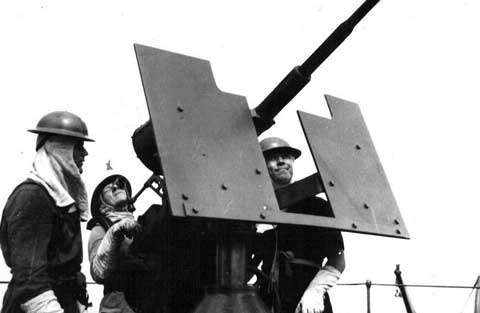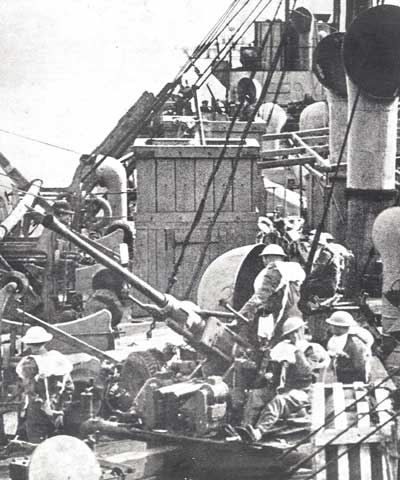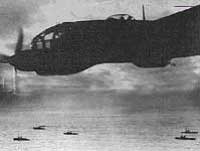It was now the 22nd December 1942 and the combined convoy KMF-5/TE-10 was in the middle of “Suicide Alley”.
Navigator’s Log book – HMS Scylla:
“0306 Friendly aircraft fired recognition signals off port bow”
Navigator’s Log book – HMS Aurora:
“0345 Two aircraft in vicinity, probably Hudsons A/S air Escort”
However, things soon changed.
Richard Day – The Rifle Brigade Cameronia:
“We were awoken very early by ‘Action Stations’ and were confined below decks in our mess area”
Lt P. Royle – Royal Artillery Cameronia:
“It must have been about 4a.m. when the third attack started and we listened to the guns yet again”
George Chadwick – Steward Cameronia:
“We get a thankful rest until 4a.m. when we have to go to ‘Action Stations’ again”
Captain G.B. Kelly – Cameronia:
“At 0359 on the 22nd December 1942, a fresh attack was made by several machines, but was successfully repelled, despite the fact that torpedoes were dropped as the planes withdrew into the clouds”
Captain Kelly’s Report centres around the torpedoing of his ship. Therefore, from his point of view, it may have been that this third attack was far less significant towards the Cameronia and therefore did not merit much reporting, only a brief mention. This view is also somewhat supported by Major Pettit.
Major P. Pettit – 17th Field Regiment Cameronia:
“At 0400 I was awakened by the alarm again and we went to ‘Action Stations’. This time we (Presumably he and his fellow Officers) simply went to sleep again as before but quicker”
However, Captain Bone’s recollection of this attack is far more detailed and far more vivid, in the main, because his ship almost collided with the Cameronia.
Captain D.W. Bone – Circassia:
“The third attack began quite unexpectedly in a blinding squall of wind and rain. We had no early warning of the approach of the enemy that on this occasion attacked from ahead. In the height of the squall and just at the moment we heard the roar of bomber engines the Destroyer on our port bow suddenly altered course and swept across our bows – uncomfortably close”
Captain D.W. Bone - Circassia:
“What she had seen or avoided was not known to us but repressing sailor inclination to swing to port and give her room we followed her lead to starboard and quickly found ourselves closing on the Cameronia that was maintaining convoy course. My old ship must have known my coming for she too bore off to starboard to give us water as I corrected the swing of the helm”
Captain D.W. Bone – Circassia:
“There was now full tongue in the convoy – a heavier note in the volume of gunfire than any we had previously experienced. What had been nearly lateral fire in the earlier engagements turned to the High Angle fire of heavier weapons. Busied with the heading of the ship, I did not observe the numbers of the aircraft that swept high overhead. The Major told me they were bombers, not torpedo bombers and their attack seemed to be directed towards the starboard wing and rearmost ships”
According to OBS records a single Ju 88 level bomber took off from I/KG 60 took off from Elmas, Sardinia at 0212, contacted KMF-5 and reporting being on the receiving end of accurate Naval light Anti-Aircraft fire. The Heinkels mentioned by Captain Bone in this fresh attack must have come from elsewhere (possibly from II/KG 26 based in Tuscany as this Gruppe unlike I & III/KG 26 remained as a level bomber Gruppe and was not converted to a torpedo bomber Gruppe). Certainly, the further east the convoy travelled, the greater the number of deployable Axis air assets there would be. Given the further availability of level bombers, the number of attack options would, weather permitting would automatically increase. Two well known tactics employed were to send in aircraft in all directions at once to counter any evasive action and to send in a mix of level and torpedo bombers. For the second tactic, the most favorable attack time was at dusk, with the torpedo bombers coming in from the darker hemisphere. The level bombers would be sent in first to throw the convoy into confusion and distract the attention of the air defences from the second wave of low flying torpedo bombers providing them in theory at least with an element of surprise. It was this second tactic which was employed in the fourth attack {see later}.

DEMS Gunners manning a 20mm Oerlikon gun (High Angle fire)
Nevertheless, if only one type of Heinkel (level or torpedo) bomber had attacked, then either Captain Kelly or Major Price must have been mistaken. Such an error could easily occur on account of sleep depravation, the bad weather, the time of the attack (night) or by simply applying the principle of ‘Occam’s razor’, a straight forward lack of basic aircraft recognition skills. One thing was certain, they were enemy aircraft and Anti-Aircraft fire continued to pour into them.

A Bofors gun onboard a cargo ship
At 0430 at position 36° 58’ N 04° 51’ E, with the attack on the convoy still in progress, the Clan Lamont altered course and began heading for the port of Bougie, (she arrived at 0700).
Navigator’s Log book – HMS Scylla:
“0435 Hostile aircraft flew up port side”
Captain D.W. Bone – Circassia:
“One great Heinkel that may have been hit as it passed close overhead on what seemed a very steep decent. As quickly as it had come up the squall of wind and rain died down. The bombers had gone”
Captain G.B. Kelly – Cameronia:
“The ‘All Clear’ was again sounded at 0510”
At 0520 all but two of the Merchantmen from TE-10 and all of the Escorts for TE-10 altered course for the port of Bougie. This meant that KMF-5/TE-10 now consisted of the following Merchantmen and Escorts:
Merchantmen
| the Cameronia, and | (originally fromGlasgow en-route to Bône) |
| the Circassia, (both Anchor Line ships) | (originally fromGlasgow en-route to Bône) |
| the Fintra and | (originally fromOran en-route to Phillipville) |
| the Transvaal | (originally fromOran en-route to Phillipville) |
Escorts
| HMS AURORA | Light Cruiser en-route to Bône |
| HMS SCYLLA | Light Cruiser en-route to Bône |
| HMS WHEATLAND | Destroyer en-route to Bône |
| HMS LAMERTON | Destroyer en-route to Bône |
| HMS QUALITY | Destroyer en-route to Bône |
These nine vessels slowly reformed into a defensive array as dictated by the Escort Commander HMS Aurora. She also so arranged matters such that each Merchantman was detailed a specific Escort to look after her (in the case of the Cameronia, this was to be HMS Scylla) whilst the Escort Commander HMS Aurora acted in an independent manner and as a general ‘Mother Hen’. With this new arrangement, the convoy continued on eastwards. The end of “Suicide Alley” was still a long way off.
Major P. Pettit – 17th Field Regiment Cameronia:
“At 0545 we stood down as before and I was told another attack had been made and the torpedo missed. (This meant that six torpedoes had now missed the Cameronia) Returned to bunk to sleep”
